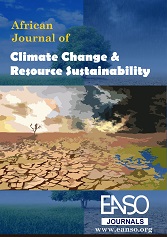Farmers’ Practice on the Management and Establishment of Bamboo Stands in Bore Woreda, Guji Zone, Oromia Region, Ethiopia
Abstract
Examining and evaluating the current body of knowledge about highland bamboo management is essential to the establishment and growth of bamboo stands. Farmers use traditional methods to manage the species. However, these indigenous ways of knowing and acting are not well documented. Therefore, the aim of this study was to characterize the techniques farmers in Ethiopia's Bor e district, Guji zone, Oromia region employ to develop and maintain bamboo stands in a sustainable manner. The selection of a sample of respondents for data collection was done through a multistage sampling technique. The first representative woreda (district) was selected from the Guji zone's bamboo-growing regions. Two representative Kebeles—the smallest unit of government in Ethiopia—were chosen at random from the chosen woreda. Face-to-face interviews, open and close-ended questionnaires, key informant interviews, and focus group discussions were used to gather primary data. Both descriptive and inferential statistics were used to analyze the data. Households had been involved in bamboo planting for almost twenty years on average. Plant spacing was 2 ± 0.9 meters on average. The households with greater incomes from the bamboo plants used management techniques including digging around the bamboo culms to loosen the soil and encourage rhizome regeneration and fencing to keep animals out. 83.7% of the respondents said they practiced management tasks such weeding, thinning, adding livestock manure, and/or composting. Since bamboo plantations still receive less attention from all stakeholders than annual crops, training should be provided to close the skill gap in propagation, processing, marketing, frost, pest and disease control, and plantation management
Downloads
References
Andargachew A. (2008). Value Chain Analysis for Bamboo Originating from Shedem Kebele, Bale Zone. A thesis report submitted to the Faculty of Business and Economics, School of Graduate Studies, Addis Ababa University, unpublished Addis Ababa, Ethiopia.
Azene Bekele, 2007. Useful Trees and Shrubs of Ethiopia: Identification, Propagation, and Management in 17 Agro-Ecological Zones. Nairobi, RELMA in the ICRAF Project, 552p
Embaye K. (2000). The indigenous bamboo forests of Ethiopia: an overview. AMBIO: J. Human Environ. 29(8):518–521.
Embaye K, Christersson L, Ledin S, and Weih M. 2003. Bamboo as a bioresource in Ethiopia:
management and strategy to improve seedling performance (Oxytenanthera abyssinica). Bioresource Technology, 88, 33–39.
Getachew Desalegn and Wubalem Tadesse (2014). Resource Communication. Resource potential of bamboo, challenges, and future directions towards sustainable management and utilization in Ethiopia. Forest Systems, 23(2): 294–299.
International Network of Bamboo and Rattan (INBAR) (2009). The Climate Change Challenge and Bamboo: Mitigation and Adaptation. No. 8, East Avenue, Fu Tong, Wang Jing Area, Beijing 100102, P.R. China. Int. J. Curr. Microbiol. Appl. Sci. 4(6):467–470.
Kelbessa E, Bekele T, Gebrehiowt A, and Hadera G (2000). The Socio-Economic Case Study of the Bamboo Sector in Ethiopia: An Analysis of the Production-to-Consumption System, Addis Ababa.
Ministry of Agriculture Natural Resources Management Directorate (MOA) (2013). Training Manual for Bamboo Stand Management and Utilization, Addis Ababa, Ethiopia.
Seyoum Gebrekidan, Lemma Tikia, and Yigardu Mulatu (2018). Indigenous knowledge on highland bamboo (Yushania alpina) management and utilization practices in Kokosa Woreda, South East Ethiopia. Sci. Res. Essays. 13(11):111-122
Tirusew Teshale, Teshale Woldeamanuel, Tsegaye Bekele, Asmamaw Alemu, and Jurgen Pretzsch (2017). Market Channels for Highland Bamboo Poles Originated in Hula District,
Sidama Zone, southern Ethiopia. Small-scale Forestry. DOI 10.1007/s11842-017-9365-2
Yigardu Mulatu and Mengistie Kindu (2010). Status of bamboo resource development, utilization, and research in Ethiopia: a review. Ethiopian Journal of Natural Resources 1: 79–98
Yigardu Mulatu and Masresha Fetene (2014). Propagation Techniques for Highland Bamboo (Arundinaria alpina) in the Choke Mountains, Northwestern Ethiopia. Ethiop. J. Agric. Sci. 24:23-36
Copyright (c) 2024 Fekadu Dule Woge

This work is licensed under a Creative Commons Attribution 4.0 International License.




























